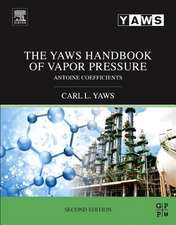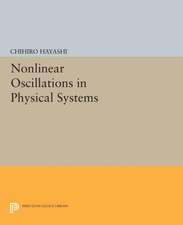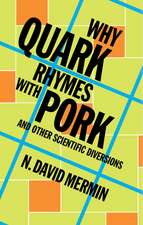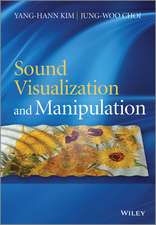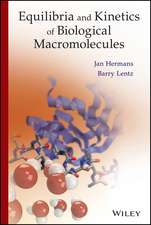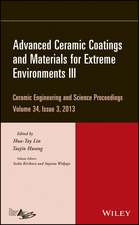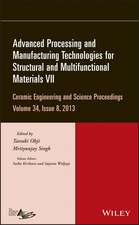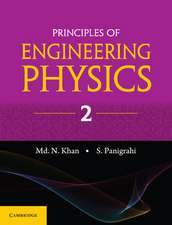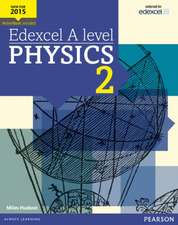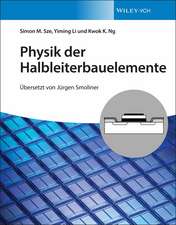Physics of Semiconductor Devices 4e
Autor SM Szeen Limba Engleză Hardback – 2 mai 2021
Preț: 707.73 lei
Preț vechi: 931.22 lei
-24% Nou
135.43€ • 139.93$ • 112.66£
Carte disponibilă
Livrare economică 27 februarie-13 martie
Livrare express 12-18 februarie pentru 54.09 lei
Specificații
ISBN-10: 1119429110
Pagini: 944
Dimensiuni: 152 x 229 x 47 mm
Greutate: 1.2 kg
Ediția:4th Edition
Editura: Wiley
Locul publicării:Hoboken, United States
Notă biografică
S. M. SZE, PHD, is Honorary Chair Professor, College of Electrical and Computer Engineering, National Chiao Tung University, Taiwan. He has made fundamental and pioneering contributions to semiconductor devices, particularly his co-discovery of the floating-gate memory (FGM) effect that has ushered in the Fourth Industrial Revolution. Dr. Sze has authored, co-authored, and edited more than 400 papers and 16 books. He is a celebrated Member of IEEE, an Academician of Academia Simica, and a member of the US National Academy of Engineering. YIMING LI, PHD, is Full Professor of Electrical and Computer Engineering at National Chiao Tung University, Taiwan. He has been a Visiting Professor in Stanford University, Grenoble INP, and Tohoku University. He has published more than 300 technical articles in journals, conferences, and book chapters. Dr. Li is an active member of IEEE and has served on technical committees for many international professional conferences including IEDM. He is the recipient of the Pan Wen-Yuan Foundation's Research Fellowship Award and the Chinese Institute of Electrical Engineering's Outstanding Young Electrical Engineer Award. KWOK K. NG, PHD, is now serving on the Industry Advisory Board of the ECE Department of Wayne State University, USA, and as Adjunct Professor at National Chiao Tung University, Taiwan. He joined Bell Telephone Laboratories in 1980, and continued in its spin-offs Lucent Technologies and Agere Systems. He was with SRC (Semiconductor Research Corp.) from 2007 to 2019. Dr. Ng is an IEEE Life Fellow and former Editor of IEEE Electron Device Letters. He is author of numerous publications, including the book Complete Guide to Semiconductor Devices.
Cuprins
Introduction 1 Part I Semiconductor Physics Chapter 1 Physics and Properties of Semiconductors--A Review 7 1.1 Introduction, 7 1.2 Crystal Structure, 8 1.3 Energy Bands and Energy Gap, 11 1.4 Carrier Concentration at Thermal Equilibrium, 15 1.5 Carrier-Transport Phenomena, 26 1.6 Phonon, Optical, and Thermal Properties, 47 1.7 Heterojunctions and Nanostructures, 52 1.8 Basic Equations and Examples, 60 Part II Device Building Blocks Chapter 2 p-n Junctions 79 2.1 Introduction, 79 2.2 Depletion Region, 80 2.3 Current-Voltage Characteristics, 91 2.4 Junction Breakdown, 102 2.5 Transient Behavior and Noise, 115 2.6 Terminal Functions, 119 2.7 Heterojunctions, 126 Chapter 3 Metal-Semiconductor Contacts 136 3.1 Introduction, 136 3.2 Formation of Barrier, 137 3.3 Current Transport Processes, 155 3.4 Measurement of Barrier Height, 173 3.5 Device Structures, 183 3.6 Ohmic Contact, 190 Chapter 4 Metal-Insulator-Semiconductor Capacitors 200 4.1 Introduction, 200 4.2 Ideal MIS Capacitor, 201 4.3 Silicon MOS Capacitor, 214 4.4 Carrier Transport in MOS Capacitor, 241 Part III Transistors Chapter 5 Bipolar Transistors 263 5.1 Introduction, 263 5.2 Static Characteristics, 264 5.3 Compact Models of Bipolar Transistors, 283 5.4 Microwave Characteristics, 293 5.5 Related Device Structures, 306 5.6 Heterojunction Bipolar Transistor, 312 5.7 Self-Heating Effects, 318 Chapter 6 MOSFETs 329 6.1 Introduction, 329 6.2 Basic Device Characteristics, 334 6.3 Nonuniform Doping and Buried-Channel Device, 360 6.4 Device Scaling and Short-Channel Effects, 373 6.5 MOSFET Structures, 391 6.6 Circuit Applications, 403 6.7 NCFET and TFET, 408 6.8 Single-Electron Transistor, 414 Chapter 7 Nonvolatile Memory Devices 434 7.1 Introduction, 434 7.2 The Concept of Floating Gate, 435 7.3 Device Structures, 440 7.4 Compact Model of Floating-Gate Memory Cells, 447 7.5 Multi-Level Cells and 3-Dimensional Structures, 450 7.6 Applications and Scaling Challenges, 463 7.7 Alternative Structures, 467 Chapter 8 JFETs, MESFETs, and MODFETs 486 8.1 Introduction, 486 8.2 JFET and MESFET, 487 8.3 MODFET, 511 Part IV Negative-Resistance and Power Devices Chapter 9 Tunnel Devices 539 9.1 Introduction, 539 9.2 Tunnel Diode, 540 9.3 Related Tunnel Devices, 554 9.4 Resonant-Tunneling Diode, 571 Chapter 10 IMPATT Diodes, TED and RST Devices 585 10.1 Introduction, 585 10.2 IMPATT Diodes, 586 10.3 Transferred-Electron Devices, 616 10.4 Real-Space-Transfer Devices, 636 Chapter 11 Thyristors and Power Devices 649 11.1 Introduction, 649 11.2 Thyristor Characteristics, 650 11.3 Thyristor Variations, 670 11.4 Other Power Devices, 676 Part V Photonic Devices and Sensors Chapter 12 LEDs and Lasers 697 12.1 Introduction, 697 12.2 Radiative Transitions, 698 12.3 Light-Emitting Diode (LED), 703 12.4 Laser Physics, 715 12.5 Laser Operating Characteristics, 723 12.6 Specialty Lasers, 742 Chapter 13 Photodetectors and Solar Cells 755 13.1 Introduction, 755 13.2 Photoconductor, 759 13.3 Photodiodes, 762 13.4 Avalanche Photodiode, 772 13.5 Phototransistor, 782 13.6 Charge-Coupled Device (CCD), 785 13.7 Metal-Semiconductor-Metal Photodetector, 799 13.8 Quantum-Well Infrared Photodetector (QWIP), 802 13.9 Solar Cell, 806 Chapter 14 Sensors 835 14.1 Introduction, 835 14.2 Thermal Sensors, 837 14.3 Mechanical Sensors, 843 14.4 Magnetic Sensors, 852 14.5 Chemical Sensors, 862 14.6 Biosensors, 867 Appendixes 875 A. List of Symbols, 877 B. International System of Units, 887 C. Unit Prefixes, 888 D. Greek Alphabet, 889 E. Physical Constants, 890 F. Properties of Important Semiconductors, 891 G. The Bloch Theorem and the Periodic Energy in the Reciprocal Lattice, 892 H. Properties of Si and GaAs, 894 I. The Derivations of Boltzmann Transport Equation and Hydrodynamic Model, 895 J. Properties of SiO2 and Si3N4, 901 K. Compact Models of Bipolar Transistors, 902 L. Discovery of the Floating-Gate Memory Effect, 910 Index 913
Descriere
The new edition of the most detailed and comprehensive single-volume reference on major semiconductor devices The Fourth Edition of Physics of Semiconductor Devices remains the standard reference work on the fundamental physics and operational characteristics of all major bipolar, unipolar, special microwave, and optoelectronic devices. This fully updated and expanded edition includes approximately 1,000 references to original research papers and review articles, more than 650 high-quality technical illustrations, and over two dozen tables of material parameters. Divided into five parts, the text first provides a summary of semiconductor properties, covering energy band, carrier concentration, and transport properties. The second part surveys the basic building blocks of semiconductor devices, including p-n junctions, metal-semiconductor contacts, and metal-insulator-semiconductor (MIS) capacitors. Part III examines bipolar transistors, MOSFETs (MOS field-effect transistors), and other field-effect transistors such as JFETs (junction field-effect-transistors) and MESFETs (metal-semiconductor field-effect transistors). Part IV focuses on negative-resistance and power devices. The book concludes with coverage of photonic devices and sensors, including light-emitting diodes (LEDs), solar cells, and various photodetectors and semiconductor sensors. This classic volume, the standard textbook and reference in the field of semiconductor devices: * Provides the practical foundation necessary for understanding the devices currently in use and evaluating the performance and limitations of future devices * Offers completely updated and revised information that reflects advances in device concepts, performance, and application * Features discussions of topics of contemporary interest, such as applications of photonic devices that convert optical energy to electric energy * Includes numerous problem sets, real-world examples, tables, figures, and illustrations; several useful appendices; and a detailed solutions manual for Instructor's only * Explores new work on leading-edge technologies such as MODFETs, resonant-tunneling diodes, quantum-cascade lasers, single-electron transistors, real-space-transfer devices, and MOS-controlled thyristors Physics of Semiconductor Devices, Fourth Edition is an indispensable resource for design engineers, research scientists, industrial and electronics engineering managers, and graduate students in the field.


